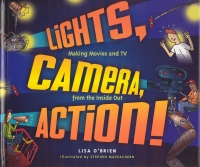| ________________
CM . . .
. Volume XIII Number 20 . . . .May 25, 2007 
 |
Lights, Camera, Action! Making Movies and TV From the Inside Out. 2nd ed.
Lisa O'Brien. Illustrated by Stephen MacEachern.
Toronto, ON: Maple Tree Press, 2007.
64 pp., pbk. & cl., $12.95 (pbk.), $21.95 (cl.).
ISBN 978-1-897066-89-8 (pbk.), ISBN 978-1-897066-88-1 (cl.).
Subject Headings:
Motion pictures-Production and direction-Juvenile literature.
Motion pictures-Vocational guidance-Juvenile literature.
Grades 6-8 / Ages 11-13.
Review by Myra Junyk.
*** /4
|
| |
|

excerpt:
Is a screenplay a blueprint? A story? A puzzle? It's all three! A blueprint is a plan that gives the workers building a house a detailed picture of what they will be building. A screenplay is like a blueprint – it gives the director, the designers, makeup artists, camera people, props, people, special effects people and actors a picture of the make-believe world they will create by making the movie.
A screenplay is a story told for the screen, with a beginning, a middle and an end. It is broken down into scenes, and these scenes are put together into acts. A scene can be any length, from a line or two to several pages, and it serves two purposes; it moves the story forward and it reveals character.
Lisa O'Brien and illustrator Stephen MacEachern give students a window into the movie-making industry in Lights, Camera, Action! Making Movies and TV from the Inside Out. The Introduction, "So You Want to be a Star," tells readers that, if they want to be actors in the movies or on television, then this is the book for them! The book is a play-by-play description of how to become an actor along with a list of resources and advice to parents.
The book is made up of six chapters describing the various facets of the movie/TV industry: screenplays, pre-production, production, post-production, marketing, and auditions. These headings give readers a picture of a media industry which is very important in our society today. The chapter on marketing movies is particularly interesting for students who may not know much about how the media "creates a buzz."
The text is very well put together with lots of colourful visuals which will appeal to young readers. Each individual section has a brief introduction and several features: graphic stories, subheadings, Director's Notes, Popcorn Quizzes (with answers later in the text), Talking To (actual interviews with movie/TV professions), and Examples from actual scripts. These features are graphically appealing with interesting and relevant information. As well, each individual chapter has a very useful glossary defining the "Screen Speak" terminology for the chapter.
Although the original text was written in 1998, this book is still relevant for readers today. For example, media literacy has recently become one of the four strands in the Language 1-8, 2006 Curriculum in Ontario. This book gives students many insights into how movies are made and how the students can become part of that industry. The authors take great care to inform students about the difficulties of the acting profession. One particularly interesting section revolves around the preparation which young actors need for their roles. They need to "hit the books" – to do their research about the parts they are playing! Great advice! The numerous interviews, examples and fast facts in the Popcorn Quizzes provide a lot of interesting and relevant information for students who are fascinated with the media.
However, one of the limitations of this resource can be found in its Introduction, "So You Want to be a Star." With its focus on becoming an actor, this book limits its appeal for students. Many students simply want to know more about the film industry and do not necessarily want to become part of it! Some students will not want to read further in this very informative media text because of its emphasis on becoming part of the acting profession. One other limitation of the text is its over-emphasis on outdated technology. Little reference is given to the idea of digitization, special effects and computer technology. There are frequent references to "video" which is now an outdated technology! If a text is to be re-issued, then it should be updated to reflect new technologies! However, regardless of these limitations, this text gives students a good picture of an industry that may mystify them!
Recommended.
Myra Junyk is the former Program Co-ordinator of Language Arts and Library Services at the Toronto Catholic District School Board. Currently, she is working as a literacy advocate and author.

To comment
on this title or this review, send mail to cm@umanitoba.ca.
Copyright © the Manitoba Library Association. Reproduction for personal
use is permitted only if this copyright notice is maintained. Any
other reproduction is prohibited without permission.
NEXT REVIEW |
TABLE OF CONTENTS FOR THIS ISSUE
- May 25, 2007.
AUTHORS |
TITLES |
MEDIA REVIEWS |
PROFILES |
BACK ISSUES |
SEARCH |
CMARCHIVE |
HOME |
